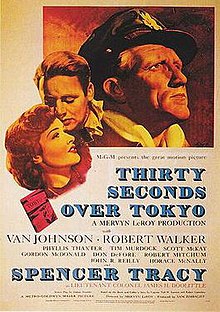Thirty Seconds Over Tokyo
| Thirty Seconds Over Tokyo | |
|---|---|

Theatrical release poster
|
|
| Directed by | Mervyn LeRoy |
| Produced by | Sam Zimbalist |
| Screenplay by | Dalton Trumbo |
| Based on | Thirty Seconds Over Tokyo by Ted W. Lawson and Robert Considine |
| Starring |
Van Johnson Robert Walker Spencer Tracy |
| Music by | Herbert Stothart |
| Cinematography |
Robert Surtees, ASC Harold Rosson, ASC |
| Edited by | Frank Sullivan |
|
Production
company |
Loew's Inc.
|
| Distributed by | Metro-Goldwyn-Mayer |
|
Release date
|
|
|
Running time
|
138 minutes |
| Country | United States |
| Language | English |
| Budget | $2.9 million |
| Box office | $6.2 million |
Thirty Seconds Over Tokyo is a 1944 American war film released by Metro-Goldwyn-Mayer. It is based on the true story of the Doolittle Raid, America's first retaliatory air strike against Japan four months after the December 1941 Japanese attack on Pearl Harbor.
Mervyn LeRoy directed Thirty Seconds Over Tokyo and Sam Zimbalist produced the film. The screenplay by Dalton Trumbo was based on the 1943 book of the same name, written by Captain Ted W. Lawson, a pilot who participated in the raid. In both the book and the film, Lawson gives an eyewitness account of the training, the mission, and the aftermath as experienced by his crew and others who flew the mission on April 18, 1942. Lawson piloted "The Ruptured Duck", the seventh of 16 B-25s to take off from the aircraft carrier USS Hornet aka, "Shangri-La."
Thirty Seconds Over Tokyo stars Van Johnson as Lawson, Phyllis Thaxter as his wife Ellen, Robert Walker as Corporal David Thatcher, Robert Mitchum as Lieutenant Bob Gray and Spencer Tracy as Lieutenant Colonel Jimmy Doolittle, the man who planned and led the raid. The film is noted for its accurate depiction of the historical details of the raid, as well as its use of actual wartime footage of the bombers in some flying scenes.
In February 1942, just two months after the Pearl Harbor attack, the United States Army Air Forces plan to retaliate by bombing Tokyo and four other Japanese cities—taking advantage of the fact that US aircraft carriers can approach near enough to the Japanese mainland to make such an attack feasible.
...
Wikipedia
